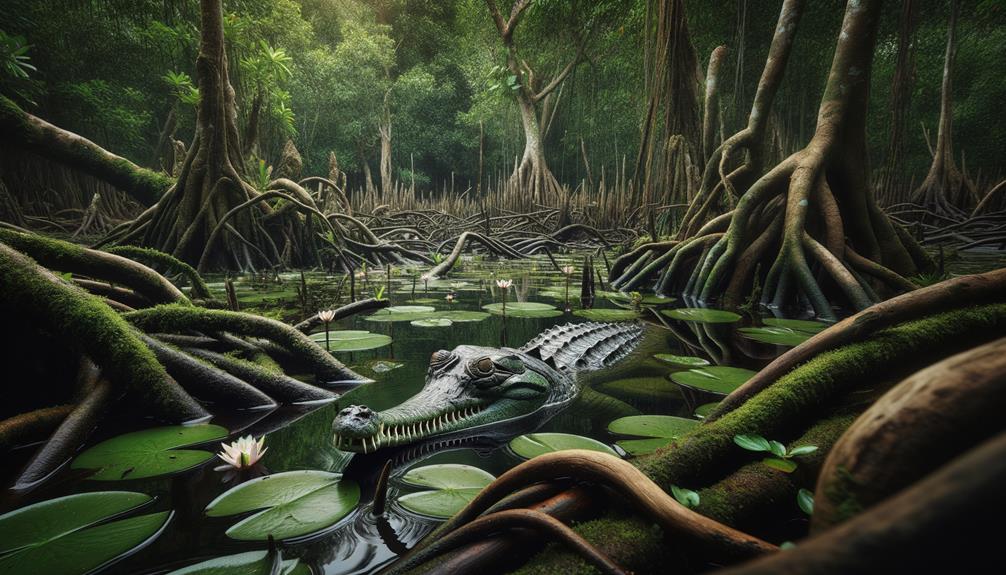Many people don't know about the False gharials living in Sumatra's swamps. These reptiles have adapted to survive in the acidic 'blackwater' rivers, a tough and unique environment. They have some cool features, like long, narrow snouts and dark reddish-brown skin. These aren't just for looks – they help the gharials hunt and hide. When it's time to lay eggs, they choose peat mounds near tall trees. This picky behavior about where they live and reproduce makes scientists really interested in them. It's especially important when thinking about how to protect these animals, since they're considered Vulnerable. Conservationists are working hard to figure out the best ways to keep these fascinating creatures safe in their special habitat.
Physical Characteristics
False Gharials catch the eye with their long, narrow snouts, perfectly suited for snagging fish. This distinctive feature isn't just for show; it's a key adaptation that highlights their hunting skills in water. Their snouts let them quickly and accurately grab fish, their main food source.
These reptiles sport a dark reddish-brown color that helps them blend in with the muddy waters and thick plants where they live. Dark spots and bands add to this camouflage, giving them extra protection. These physical traits aren't just about looks; they're crucial for survival.
Male False Gharials can tip the scales at 150 to 250 kilograms, while females usually grow to about 3.2 meters and weigh around 90 kilograms. Their size makes them top dogs in their watery homes. The long snouts and unique patterns show how well they've adapted to their environment, striking a balance between form and function as they've evolved over time.
Habitat and Adaptations

The false gharial's habitat in Sumatra's peat swamp forests is a marvel of nature. These reptiles thrive in the acidic 'blackwater' rivers, which perfectly suit their low-energy lifestyle. Their long, thin snouts are ideal for snatching fish in the murky waters. Come nesting season, they build their homes at the base of towering trees on peat mounds. These specific environmental conditions are crucial for their survival, highlighting the need for targeted conservation efforts. The intricate relationship between the false gharial and its ecosystem underscores the importance of protecting these unique habitats for future generations.
Swamp Ecosystem Characteristics
Peat swamp forests play a crucial role in the survival of false gharials, found in Sumatra, Borneo, and Peninsular Malaysia. These ecosystems, with their rain-fed blackwater rivers and nutrient-poor soils, offer ideal conditions for these unique crocodilians. Despite the challenging environment, false gharials have adapted remarkably well to the acidic waters and low-nutrient soils that characterize these forests.
False gharials typically build their nests at the base of large trees or on raised peat mounds near permanent waterways. This strategic placement ensures easy access to essential resources. The significance of these habitats extends beyond false gharials, supporting a wide range of species and contributing to overall biodiversity.
Key aspects of peat swamp forests include:
- Dark, tea-colored rivers: Rich in organic matter but low in nutrients, these waterways support specialized life forms.
- Elevated nesting sites: False gharials depend on these spots to protect their eggs from flooding.
- Conservation priority: Protecting these swamps is vital for maintaining biodiversity and preventing species loss.
- Ecological importance: These ecosystems serve as carbon sinks and help regulate water levels in the surrounding areas.
Understanding and preserving these unique habitats is essential for the long-term survival of false gharials and numerous other species that call peat swamp forests home.
Unique Survival Strategies
False gharials have some pretty cool ways of staying alive in the tough peat swamp forests. These reptiles make their home in Sumatra's rainy streams, showing they're picky about where they live. Their eyes and nostrils sit on top of their heads – a clever trick that lets them stay mostly underwater while hunting. This sneaky approach comes in handy in the acidic 'blackwater' rivers of peat swamps, where the soil and water don't have many nutrients, creating a tricky environment to survive in.
When it comes to laying eggs, false gharials are smart about it. They pick spots at the bottom of big trees on small peat hills near steady streams. This clever choice keeps their eggs safe from floods and hungry predators, giving their babies the best shot at survival. To keep these creatures around, we need to focus on protecting their specific habitats in Sumatra and Kalimantan. After all, without large peat swamp forests, false gharials wouldn't stand a chance.
Diet and Hunting Techniques

False gharials are impressive hunters, using their patience and sneaky nature to catch a wide range of prey. These reptiles, found in Sumatra's freshwater swamps, are masters of the surprise attack. They stay still as statues until the perfect moment to strike.
Their long, thin jaws packed with sharp teeth are perfect for grabbing slippery fish, which make up most of their meals. But these crafty creatures don't stop there. Their menu is quite varied:
- Fish: The go-to meal for false gharials. They're quick to snap up fish swimming by, using their keen sense of touch and fast reflexes.
- Crabs and shrimp: These add some crunch and variety to their diet.
- Frogs and small reptiles: Anything that shares their watery home is fair game.
- Sometimes, bigger animals: They've been known to take on monkeys or rodents, showing they can adapt their hunting style when needed.
This diverse diet helps false gharials thrive in their swampy homes. They're not picky eaters, which is a big plus when you're a top predator in a challenging environment.
Reproduction and Life Cycle

False gharials have an interesting way of reproducing. They build mound-nests and lay between 13 and 35 eggs in each one. This clever approach helps their young survive even though the parents don't stick around to care for them. These reptiles typically mate during the rainy season, from November to March, when conditions are just right for their eggs to develop and hatch.
After laying her eggs, the female takes off, leaving the nest behind. But don't worry – the carefully chosen nesting spot and the protective mound do a good job of keeping the eggs safe from threats and harsh weather. The eggs need about 90 days to hatch.
When the baby gharials emerge, they're on their own from the get-go. They're born with survival instincts, but face plenty of challenges in their new world. The parents' hands-off approach after hatching shows how little direct care they provide to their offspring. Instead, these reptiles rely on laying lots of eggs and timing their breeding just right to make sure enough babies make it to adulthood. This reproductive strategy shows how well they've adapted to Sumatra's swampy environment.
Interactions With Other Predators

False gharials and Mugger Crocodiles often clash over territory and food. These run-ins highlight the stark differences in their hunting styles. False gharials are fish-catching specialists, while Muggers have a broader menu. To avoid confrontations, false gharials use smart tactics. They're aware of their weaker snouts and lower endurance compared to their tougher cousins. This savvy approach helps them steer clear of unnecessary scuffles in their shared habitats.
Territorial Disputes and Boundaries
False gharials in Sumatra's swamps often butt heads with saltwater crocodiles over the best hunting spots and nesting areas. It's a tough world out there, and these long-snouted reptiles have to fight for their piece of the pie. But it's not just crocs they're up against.
These gharials also have to deal with:
- Reticulated pythons: These giant snakes are after the same food, leading to some serious competition.
- Big monitor lizards: These opportunistic eaters sometimes raid gharial nests.
- Other false gharials: Family feuds can get pretty nasty, especially during mating season.
- Human activity: People are moving in on gharial turf, stirring up more trouble.
Getting a handle on these turf wars is key for protecting these animals. When things get heated, gharials can end up hurt or pushed out of their homes, which messes with their numbers and where they live. To really help these critters, we need to understand the whole picture of what they're dealing with in Sumatra's swamps. By tackling these disputes head-on, we can better tailor our efforts to keep both the gharials and their home turf in good shape, even as the world around them keeps changing.
Prey Competition Dynamics
The swamps of Sumatra aren't just home to false gharials – they're bustling ecosystems where various predators jostle for limited resources. These freshwater habitats host a complex web of interactions, with false gharials at the center of a fierce competition for prey.
Fish-eating birds like herons and egrets are常常 vying for the same meals as false gharials. This creates a delicate balance in the food chain, where each species must adapt to survive.
Crocodiles add another layer to this competitive mix. The imposing Saltwater Crocodile and the Mugger Crocodile are formidable rivals, especially during dry spells when water levels dip and prey becomes scarce. These periods see heightened tensions among predators as they scramble for food.
Otters and large fish species, including catfish and carp, also factor into this ecological puzzle. Each plays a role in the ongoing struggle for sustenance.
For conservationists, grasping these intricate prey dynamics is key. Maintaining healthy food sources in Sumatra's swamps isn't just about false gharials – it's about preserving the entire ecosystem. Smart conservation plans need to account for these complex relationships to keep the system in check.
Predator Avoidance Strategies
False gharials, known for their delicate snouts, have developed clever ways to avoid run-ins with bigger threats like Mugger Crocodiles. These tactics are crucial, given their specialized fish-catching skills. Their fragile snouts make aggressive encounters risky, so staying out of harm's way is key to their survival.
When it comes to dealing with Mugger Crocodiles, False Gharials stick to a few smart moves:
- Living in different spots: They often hang out in areas where Mugger Crocodiles don't, cutting down on face-to-face meetings.
- Hunting at odd hours: They might snack when other predators aren't around, reducing the chance of bumping into them.
- Showing they're not a threat: Using subtle body language, they can signal submission and avoid fights with bigger creatures.
- Sticking to what they do best: Their unique snouts let them focus on catching prey that doesn't need the strong jaws their cousins have.
These tactics show how False Gharials have adapted to their surroundings, allowing them to thrive despite living alongside formidable predators. Their knack for avoiding trouble while carving out their own niche in the ecosystem proves just how tough and specialized they really are.
Conservation Efforts

The false gharial's survival hangs in the balance, with the IUCN listing it as Vulnerable due to widespread habitat destruction and human encroachment. Protecting key areas like Sumatra's peat swamp forests is crucial, as deforestation and farming have severely reduced these vital ecosystems.
In Sumatra, local communities are central to preservation efforts. Traditional beliefs in Sarawak and East Kalimantan encourage fishers to release caught false gharials, indirectly supporting conservation. Involving these communities ensures a more sustainable approach to protecting the species.
Breeding programs in captivity offer another ray of hope. By studying population trends, conservationists can introduce individuals back into the wild, strengthening existing populations. These initiatives work alongside ongoing research and monitoring to address major threats.
| Strategy | Actions | Outcome |
|---|---|---|
| Protecting Habitats | Safeguard peat swamp forests | Preserves natural environments |
| Local Involvement | Collaborate with nearby communities | Encourages sustainable practices |
| Captive Breeding | Reproduce and release false gharials | Boosts population numbers |
These varied approaches are vital for the false gharial's continued existence. Each strategy, from protecting habitats to involving local communities and breeding programs, plays a key role in safeguarding this unique species.
Frequently Asked Questions
Where Can I See Wild False Gharial?
Wild False Gharials can be spotted in protected areas across Southeast Asia. Your best bet for seeing these hard-to-find reptiles is to visit national parks and reserves in Sumatra, Borneo, Peninsular Malaysia, and certain parts of Indonesia. These regions offer the most promising opportunities to observe False Gharials in their natural environment. Keep in mind that these creatures are quite elusive, so patience and a bit of luck might be necessary during your wildlife-watching expedition.
What Was the Bite Force of the False Gharial?
While researchers haven't pinpointed the exact bite force of the false gharial, it's clearly nothing to sneeze at. These reptiles can crunch through the shells of turtles and take down sizeable mammals, which speaks volumes about their chomping power. As top predators in their ecosystems, false gharials have evolved some seriously impressive jaws to handle their diverse menu of prey.
What Is the Difference Between True Gharial and False Gharial?
The main contrast between true and false gharials is in their snout shape. True gharials sport a distinctive bulbous growth at the tip, while false gharials lack this feature. False gharials also have a thicker snout that tapers gradually, and their skin stands out with a dark reddish-brown hue dotted with spots. These differences help researchers and wildlife enthusiasts tell the two species apart in their natural habitats.
Is False Gharial Extinct?
The false gharial isn't gone yet, but it's hanging on by a whisker. With fewer than 2,500 adults left, these rare crocodiles face serious trouble. Their biggest enemy? Vanishing homes. Saving them requires swift action and dedicated conservation work. Without it, we might lose these unique creatures for good.



